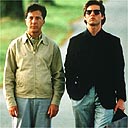"Broken Blossoms" (1919)
- GoogaMooga
- custodian of oldies
- Posts: 30379
- Joined: 28 Sep 2010, 05:23
- Location: Denmark
"Broken Blossoms" (1919)
For my Sunday matinée, I streamed a film that is now 100 years old, "Broken Blossoms", by the Father of Cinema, D.W. Griffith. We saw a print in which the 1922 color tints were preserved, and they, like the music, certainly added a lot to the atmosphere and mood of the film. Color tinting and music were important in those days, when that vital element, sound, was missing. But a good silent does not really need sound; through mise-en-scene, lighting, and editing, you can convey all that you need to get a narrative drive and convey whatever message you have. At 67 minutes, it was not a minute too long, and apart from a few "theatrical" gestures and expressions, it felt very modern. It is Akira Kurosawa's favorite film, and it is definitely one of my favorite silents. The cross-cutting, which Griffith perfected, works very well here, building tension, as the melodrama unfolds. It is a tragic love story, about a Chinese immigrant in London's Limehouse district, who falls in love with a mistreated young waif, played with great sensitivity by Griffith's number one leading lady, Lillian Gish. Griffith was still atoning for "Birth of a Nation" in 1919, and he never really recovered from the misstep of that film. No bigotry or xenophobia in "Broken Blossoms", though, which contrasts East and West with dignity and thoughtfulness. He draws parallels between Buddhism and Christianity, breaking down misconceptions and barriers. The Golden Rule is spouted in an early scene back in China, where drunken sailors engage in a brawl. It is Griffith preaching universality and pantheism, not to be confused with moral or cultural relativism. The film has a poetic luster, both in the art direction and in the lighting, underscored by poetic musings on life, death, and human nature in the sparsely scattered inter-titles. The pathos we are presented with is beautiful, just beautiful, and we become one with the film, immersing ourselves in cinema in its purest form.

"When the desert comes, people will be sad; just as Cannery Row was sad when all the pilchards were caught and canned and eaten." - John Steinbeck
